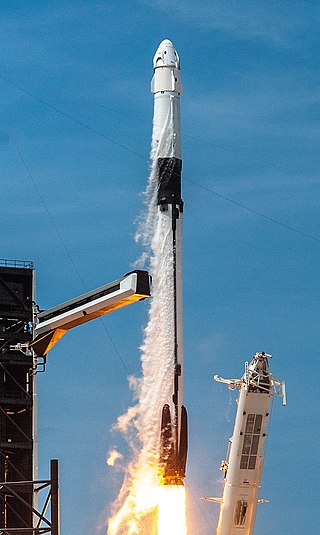Top Qs
Timeline
Chat
Perspective
Comparison of orbital launch systems
From Wikipedia, the free encyclopedia
Remove ads
Remove ads
This comparison of orbital launch systems lists the attributes of all current and future individual rocket configurations designed to reach orbit. A first list contains rockets that are operational or have attempted an orbital flight attempt as of 2024; a second list includes all upcoming rockets. For the simple list of all conventional launcher families, see: Comparison of orbital launchers families. For the list of predominantly solid-fueled orbital launch systems, see: Comparison of solid-fueled orbital launch systems.

Spacecraft propulsion[note 1] is any method used to accelerate spacecraft and artificial satellites. Orbital launch systems are rockets and other systems capable of placing payloads into or beyond Earth orbit. All launch vehicle propulsion systems employed to date have been chemical rockets falling into one of three main categories:
- Solid-propellant rockets or solid-fuel rockets have a motor that uses solid propellants, typically a mix of powdered fuel and oxidizer held together by a polymer binder and molded into the shape of a hollow cylinder. The cylinder is ignited from the inside and burns radially outward, with the resulting expanding gases and aerosols escaping out via the nozzle.[note 2]
- Liquid-propellant rockets have a motor that feeds liquid propellant(s) into a combustion chamber. Most liquid engines use a bipropellant, consisting of two liquid propellants (fuel and oxidizer) which are stored and handled separately before being mixed and burned inside the combustion chamber.
- Hybrid-propellant rockets use a combination of solid and liquid propellant, typically involving a liquid oxidizer being pumped through a hollow cylinder of solid fuel.
All current spacecraft use conventional chemical rockets (solid-fuel or liquid bipropellant) for launch, though some[note 3] have used air-breathing engines on their first stage.[note 4]
Remove ads
Current rockets
Summarize
Perspective
Orbits legend:
- LEO, low Earth orbit
- SSO or SSPO, near-polar Sun-synchronous orbit
- polar, polar orbit
- MEO, medium Earth orbit
- GTO, geostationary transfer orbit
- GEO, geostationary orbit (direct injection)
- HEO, high Earth orbit
- HCO, heliocentric orbit
- TLI, trans-lunar injection
- TMI, trans-Mars injection
- Despite not being officially acknowledged by the manufacturer, significant changes between different iterations of the rocket lead to the identification of different variants.[13]
- 5,100 kg to a 500-km Sun-synchronous orbit; 3,300 kg to 800 km[34]: 64–65
- Despite not being officially acknowledged by the manufacturer, significant changes between different iterations of the rocket lead to the identification of different variants.[39]
- Additionally, two suborbital missions were conducted in 2010 and 2011.[98]
- A suborbital test flight succeeded in 2016.[124]
- Suborbital test flight in 2004, without Fregat upper stage.[127]
Remove ads
Rockets in flight testing
Summarize
Perspective
Remove ads
Upcoming rockets
Summarize
Perspective
Upcoming launch vehicles
Remove ads
Retired rockets
Launch systems by country
The following chart shows the number of launch systems developed in each country, and broken down by operational status. Rocket variants are not distinguished; i.e., the Atlas V series is only counted once for all its configurations 401–431, 501–551, 552, and N22.
10
20
30
40
50
AUS
BRZ
CHN
EUR
ESP
FRA
IND
IRN
ISR
JPN
NKR
NZL
RUS
SKR
TWN
UKR
UK
USA
- Operational
- In development
- Retired
Remove ads
See also
- Comparison of orbital launchers families
- Comparison of orbital rocket engines
- Comparison of crewed space vehicles
- Comparison of retired orbital launch vehicles
- Comparison of space station cargo vehicles
- List of space launch system designs
- Reusable launch system
- List of orbital launch systems
- Lists of rockets
- List of sounding rockets
- List of upper stages
- Non-rocket spacelaunch
Notes
- There are many different methods. Each mestylethod has drawbacks and advantages, and spacecraft propulsion is an active area of research. However, most spacecraft today are propelled by forcing a gas from the back/rear of the vehicle at very high speed through a supersonic de Laval nozzle. This sort of engine is called a rocket engine.
- The first medieval rockets were solid-fuel rockets powered by gunpowder; they were used by the Chinese, Indians, Mongols and Arabs, in warfare as early as the 13th century.
- Such as the Pegasus rocket and SpaceShipOne.
- Most satellites have simple reliable chemical thrusters (often monopropellant rockets) or resistojet rockets for orbital station-keeping and some use momentum wheels for attitude control. Soviet bloc satellites have used electric propulsion for decades, and newer Western geo-orbiting spacecraft are starting to use them for north–south stationkeeping and orbit raising. Interplanetary vehicles mostly use chemical rockets as well, although a few have used ion thrusters and Hall effect thrusters (two different types of electric propulsion) to great success.
Remove ads
References
Wikiwand - on
Seamless Wikipedia browsing. On steroids.
Remove ads
